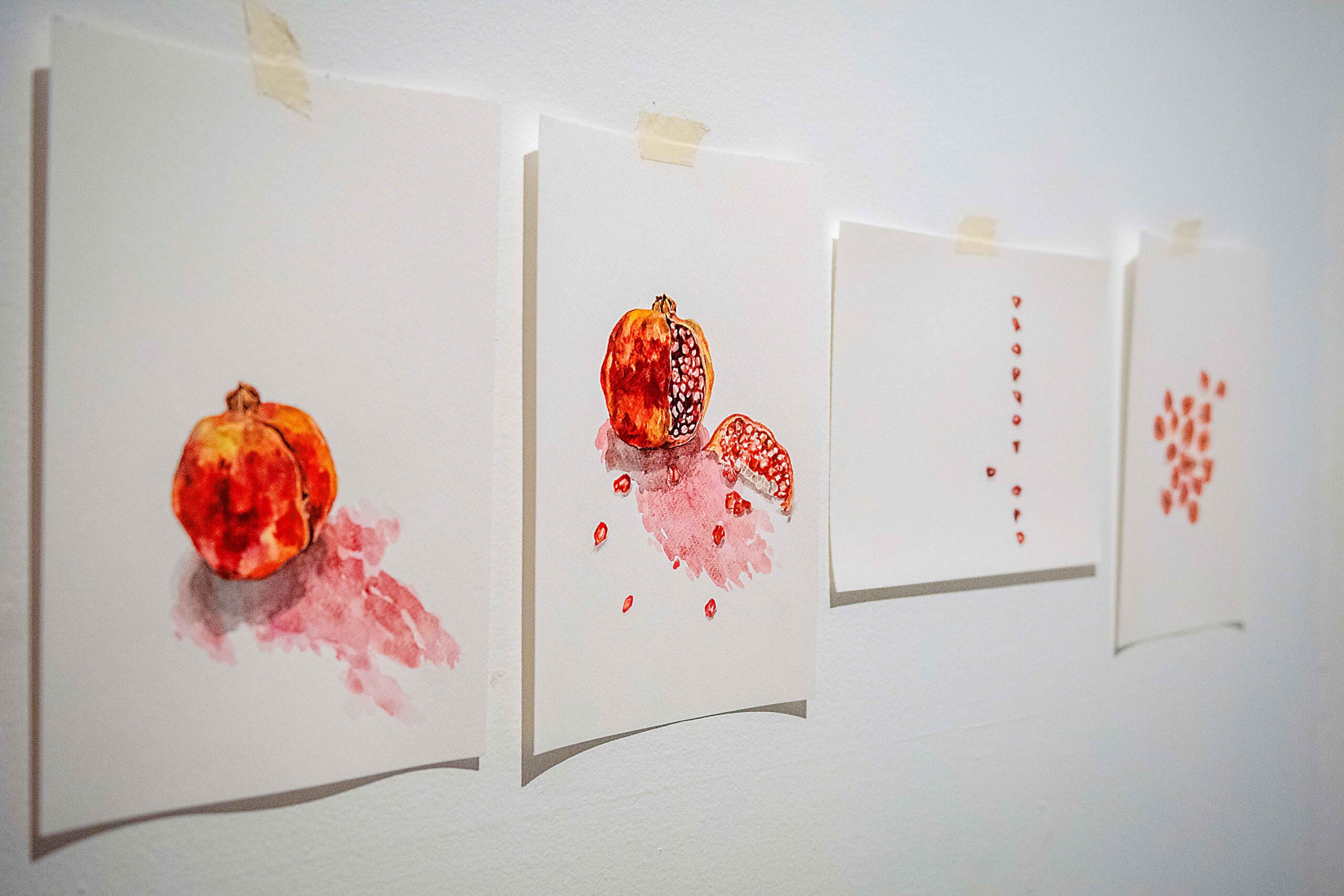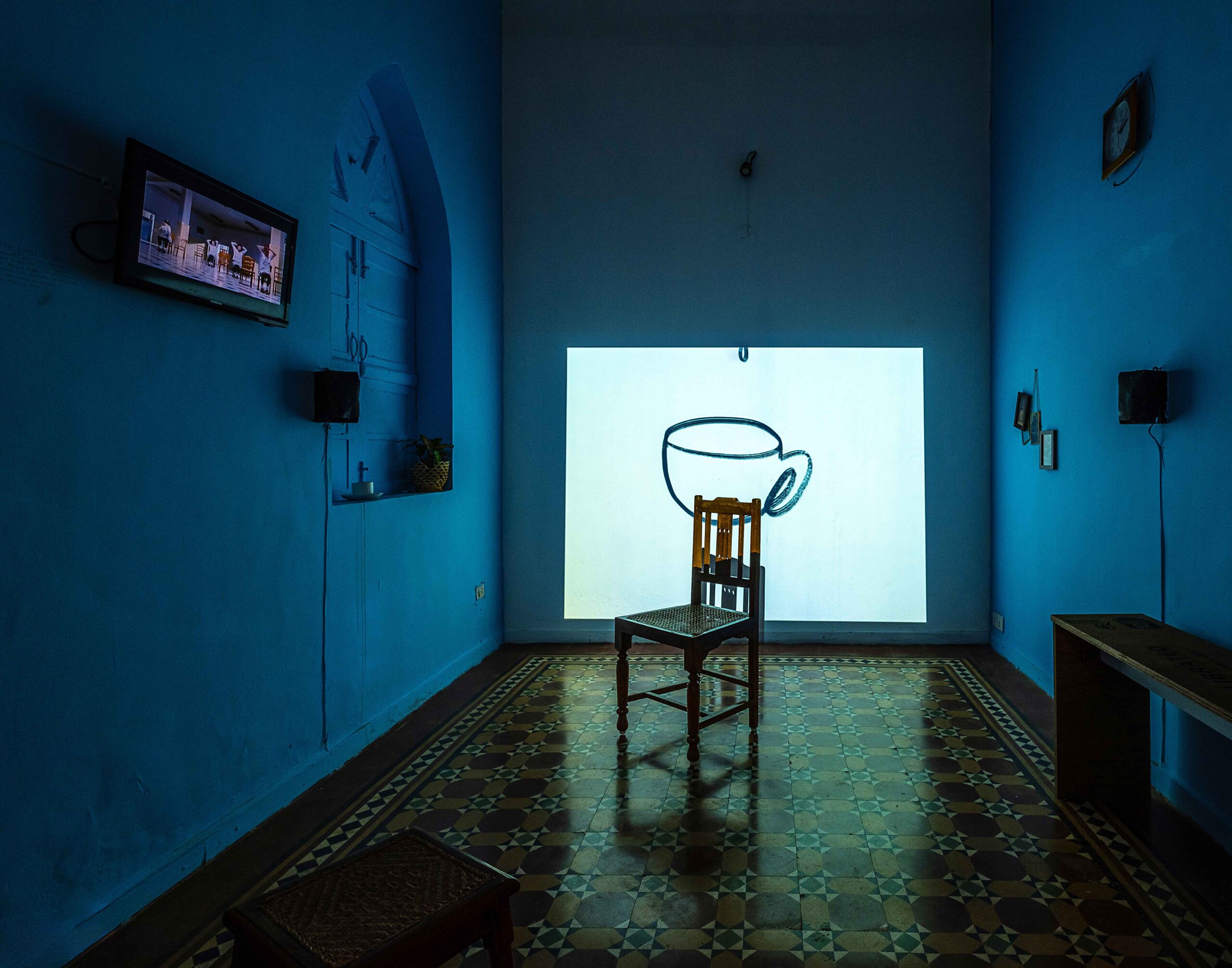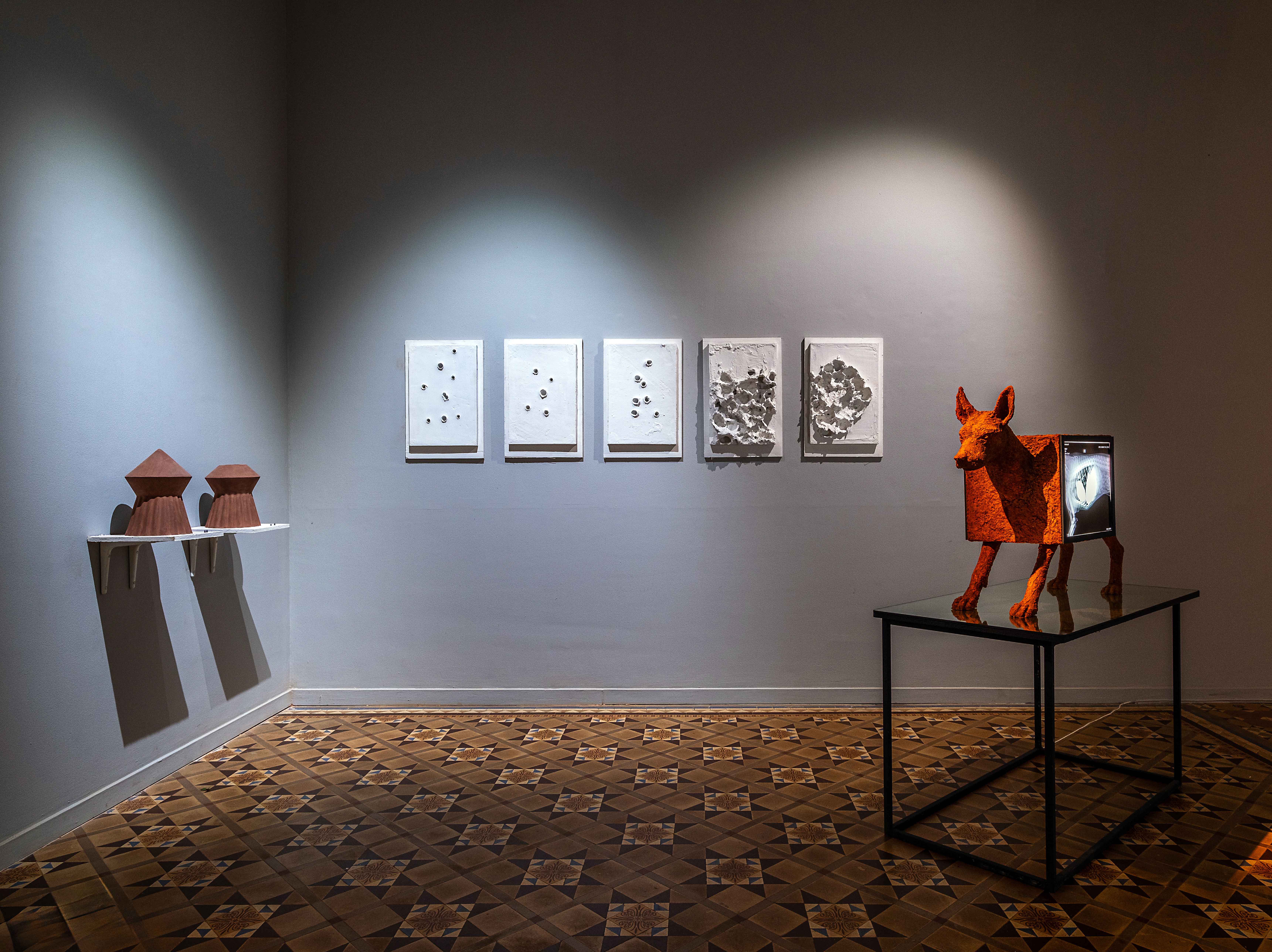
Priyanka Mishra, Image Courtesy: Sunaparanta Goa Centre for
the Arts and Utpal Chakravart
In Between is a group exhibition that was open for viewing at Sunaparanta Goa Centre for the Arts, in Panaji-Goa from 28 June 2023 to 15 July 2023, that culminated as a result of the collective display by 11 participants of the second edition of the Sunapranta Art Initiator Lab, a mentorship program for creative practitioners, developed and led by Lina Vincent, a Curator, and an Art Historian.
The SAIL program has been designed to help the selected candidates build research, incubate ideas, refine techniques, and develop the scope and opportunities with access to a community, network, and showcase. In between is conceptualized, curated, and executed by the 11 artists under the mentorship.
The group shows that works in process resonate with the multiplicity that lies within spaces, ideas, emotions, movements, and concepts, summarizing the essence of voids, spaces, intersections, and overlays. It explores the space within two dots, approaching the dialectical opposition between material and ideas, reality and meaning, past and present, expanding the dot into a line, exploring, enquiring, and recording the space in between its beginning point and the imagined end with infinite possibilities and interdisciplinary languages of expression.
In a collective, our works are like circles that meet within the intersections creating links in these overlaps and intend to tell a story using these relations. The artists explored different definitions and existences of the idea of what lies within two ends, at different levels and spaces.
Antara Majumdar, a contemporary dancer and choreographer with a background in philosophy and contemporary dance, explores how movement, rests and transitions through repetitions and loop-in movements compared with the mundane and routine circles of daily life.
“Are loops derivative of specific environments? How often do we find ourselves executing identical loops in dissimilar environments? Are gestures micro representations of repetitive circularity? What happens when a gesture changes?” are some of the inquiries Antara addresses through her installation and performance in a loop using a tea stall set up as a mask.
Anup Anand Naik is a visual art practitioner based in Goa. His introspective art practice playfully traverses metaphors and references from semiotics, pop culture & nostalgia, venturing through multiple disciplines and mediums. Anup’s work is charged with illustrated episodes of ‘psychological fiction’ in a comic book pattern. The content of the comic puts a spotlight on his constant and deliberate attempt to face and explore unconscious fears from his psyche. He attempts to revisit and reconstruct his psychological unfolding through this series he calls The Cautionary Tale.
Dattaraj Naik is a multidisciplinary visual artist, muralist, and art educator based in Goa. His work acts as a commentary on the emoji as being an effective tool and channel for communication in this digital age and space, acting as the catalyst for distance and presence, conveying in the most effective ways in these scenarios.
“For over the past 20 years emojis/emoticons (visual representations of emotions) have gone from a niche Japanese experiment to a global phenomenon. As a visual practitioner, I realize how emojis play a major role in making our text conversations more effective and expressive. I began to create my region-specific characters inspired by emojis and started using them as my medium of expression,” says Dattaraj. His work also showcases social, political, and environmental issues, which act for change, through the construction of an interactive game as his expression.
Dattaraj notes, “The protagonist in the game will go through a number of situations and environments in which he has to interact and make choices to proceed in the game. Though this artwork is straightforward visually and could be understood by anybody, I primarily want to communicate with the youth who are mostly involved in gaming. Youth has the power to bring about change and make this world a better place.”

Majumdar, Image Courtesy: Sunaparanta Goa Centre for the
Arts and Utpal Chakravarty
Divesh Gadekar is a multidisciplinary artist based in Goa mostly working with sound, form, visuals, and their intersection. His is a research-based project about musical instruments, their structure, and history, focused on helping to revive these musical instruments that are on the verge of extinction, with the help of the last few artists who are still aware of the process of making and playing them: Pawa / Murali & Surpawa/Konpawa.
Divesh says, “Every musical instrument has its own language. Also, the sound of the particular instruments can describe the tone of a language, which they speak. A community lifestyle also can be reflected through the sound of an instrument.”
Manashri Pai Dukle is an artist, art historian, and educator based in Goa. Her practice encompasses explorations of the undefined structures, ritual frameworks, word and meaning relations, setting a dialogue within liminality, evoking emotions and quests for the endpoints, constructing dioramas and reconstructing memoirs, with images, archives, and objects as the key elements in the conceptual renders of imagined systems, spaces, and histories creating a series of interactions that explores the idea of loss and abandonment in an undefined, unrecognized space creating an imagined narrative around the idea of the last experience of something or someone in a void, metaphorically in her installation ‘letters to the Void’; observing the oscillating spaces within identities, enquiring the process of sharing information, mark making, migration, recognition patterns and impressions, tracing back origin points reached through non-evident spaces between the beginning and receiving end. With an attempt to capture liminality, through objects-interactions, resolving a quest for identity and belonging through sensory interactions and dioramas.
The project also works in continuation with the imagined histories and interrelations with a filter of anonymity creating a channel tracing back the structure of knowledge fluidity emerging from an unknown end, passing on in an inexplicable void. This project invites and encourages engagement and provides an outlet to share imagined histories, intergenerational knowledge, superstitions, ritual narrations, and individual understanding and perceptions. This is an ongoing project and the voice and words shared and collected through this interaction will work towards building a further dialogue within a physical space constructing an imagined version of it.
Priyanka Mishra, a visual artist and an art educator based in Goa, explores the themes of motherhood, mental health, and societal stigmatization within the domestic realm. Drawing from her personal experiences of grappling with anxiety, overthinking, and postpartum depression, she employs a cathartic approach to her work. By constructing an extensive compilation of thoughts, including personal memoirs, phrases, questions, and doubts, she aims to initiate a broader dialogue about mental health and the human experience through her interactive poems in visuals including “While I Lay Awake”, “Pomegranates from my fridge” and “The Cloud in My Head” through the medium of video, drawing, and installation. In the words of Priyanka, “The cloud in my head captures the heightened moment of an internal struggle, the overwhelming thoughts that accompany anxiety’s grip. The cloud depicts individual memoirs collected through an anonymous survey inviting people to share their overwhelming thoughts when they are engulfed in the loop of overthinking and anxiety. The cloud symbolizes a mass of shared vulnerabilities, rapidly accumulating, fleeting in its existence, and ultimately dispersing, showcasing its transient nature.”
Ramona Dias is an artist who primarily works with oil paints and soft pastels, while Shivranjana Rathore is an author and maker of things dedicated to her love for meaning-making and existential exploration through different creative mediums. Chrysalis is an iteration of a long-form collaborative project between Shivranjana and Ramona, which brings together their journeys and interpretations, of and through the human psyche. “The work seeks to capture the experience of metamorphosis within the persona. Each artist, coming from their own creative journeys explores through sculptures, poetry, and sound, an experience of the liminality of transformation. What happens when the hero sees their own unexplored darkness, or the villains find a hidden wound? What happens between the binaries of good and bad, dark and light, one identity and another? In a world married to the comforts of certainty and ideas of selfhood, the Chrysalis captures that precise moment of anarchy, when the human-ness of our realities sinks in, and we learn that we remain forever in transit.”
They explain through The Outsider an individual project by Shivranjana in the form of a sculptural zine, she attempts to explore the ideas of belonging, the identity labels of insider-outsider, inclusion, and exclusion and their consequences – from passive relational tensions to communal riots – especially, in a deeply migratory and increasingly globalized world. “This piece seeks to allow people to reflect on and question the meaning of identity and belonging and their tight relationships with place, and ownership; along with their friction-creating coexistence with the amorphousness of movement,” says Shivranjana.

Goa Centre for the Arts and Utpal Chakravarty
Sanayvi Naik’s works are structured into a satirical commentary on the socio-political day-to-day events he comes across. His works display human tendencies like greed, ignorance, treachery, and the search for one’s own identity. His exhibit, called No Man’s Land, centres around the traumatic incident, with his pet dog Bruno being attacked with a bullet for entering a territory outside his owner’s ownership. Bruno as the protagonist, narrates the concepts of ownership and land politics through Snayvi’s sculptural pieces. “As I researched further, I realised that this story is not just about our dog, but about the broader issue of coexistence and harmony between humans and animals. This is a personal issue for me, but it is also a problem that is affecting both urban and rural societies the world over. We must take responsibility for creating spaces of love and care,” adds Sanayvi.
Satyam Malhar belongs to the farming community of Sawantwadi situated in Southern Maharashtra. His current practice is a visual translation of his experiences on the farm. He incorporates elements commonly used on land, where they grow rice, cashew nuts, mango, indigenous vegetables, and flowers for local consumption, within his artworks through his realistic renderings.
His paintings in performance narrate his preoccupation with the night landscape revisiting it through the lens of an observer; he relates this with the concept of “Rakhandar”, the night watchman, unveiling his wish to represent this experience of the night and conversations with the self, under the moonlight, introspecting and asking questions that haunt his every day of being caught in the crux of urban and rural reality.
According to Sattyam, “The darkness of the landscape is a metaphor for the unknown as I traverse through it to protect it and myself. This landscape is infested with bison, monkeys, wild pigs, and other creatures. We try to frighten them by installing scarecrows that are proxies for humans, but the animals gradually realize our trap to frighten them and continue their havoc of raiding the crop. Here the moonlight guides my path by creating mysterious shadows and chiaroscuro to heighten the sense of drama. Light and shadow, hide and seek, hunter and the hunted, these are like yin and yang that complement each other. We are protecting our harvest and ourselves in this battle for survival.”
Utpal Chakravarty, a civil engineer by profession and a self-taught photographer by passion, mainly works with monochrome photography with the ultimate goal of igniting a sense of connection and understanding among viewers, transcending cultural, geographical, and social barriers. Weathered Glory is a photography project by him that explores the allure of abandoned objects and edifices, the stories they tell, and the emotions they evoke. The project covers locations ranging from decaying urban landscapes to desolate rural areas, each subject bearing witness to the passage of time. Utpal adds, “The images depict the transitory nature of life and the inherent beauty in ageing, and lead the viewer on a journey of reflection and introspection.”
In Between is an exploration of the unknown, the undefined, the unpaused, and the paused. It constructs, deconstructs, and reconstructs human existence by touching subjects as sensitive as human connections, emotions, and loss, as well as political definitions like ownership, and community identity. It documents and archives history, and it also unwraps these collections through different mediums and materials as a collective weave.
Read More>> Please Subscribe our Physical Magazine
